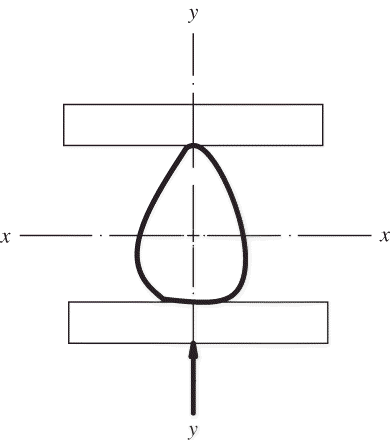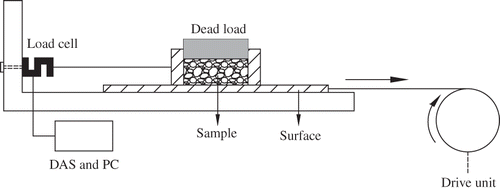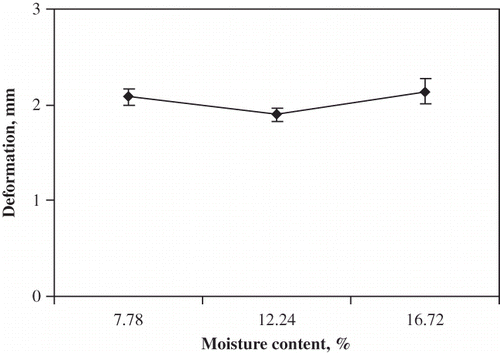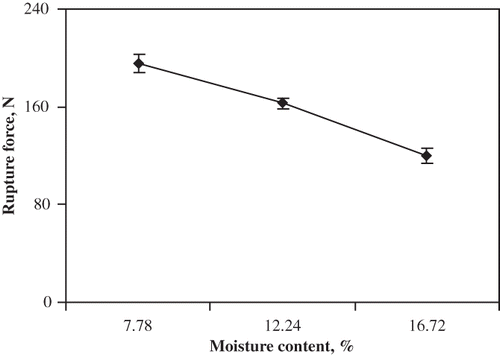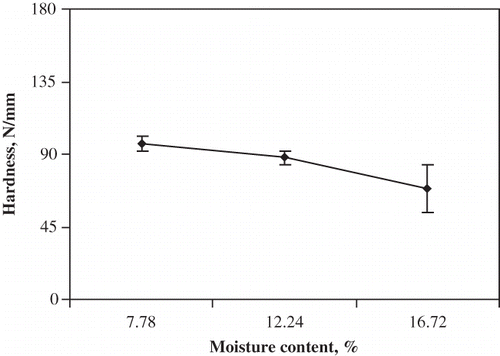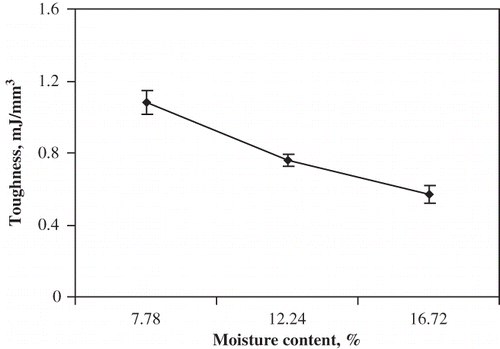Abstract
Strength properties and dynamic coefficient of friction of popcorn kernels were evaluated as a function of moisture content in the range of 7.78–16.72 g/100 g dry solids. In order to determine strength properties of the kernels that are in terms of deformation at rupture point, rupture force, energy absorbed, hardness, and toughness of the popcorn kernels were quasi-statically loaded between two parallel plates. To determine frictional properties, friction tests were performed on aluminum, steel, and fiberglass surfaces. The values related to the strength properties, in general, decreased as the moisture content increased. On the other hand, the dynamic coefficient of friction of the popcorn kernels increased with increasing moisture content.
INTRODUCTION
Popcorn quality cannot be developed after its harvest, only maintained. Therefore, it is highly important to preserve and maintain the pre-existent quality of the kernel. Unfortunately, during harvest and post-harvest, quality of the kernel is reduced owing to several operations. The data related to the strength and frictional properties of agricultural products are necessary both to design units, equipments, and machines, which are the kernel quality-centered during harvesting, handling, transportation, separating, drying, aeration, sizing, storing, packing, and the other processing, and to determine the parameters of engineering of these units. Accordingly, the strength and frictional properties are needed not only by agro-machine manufacturers but also food scientists.
Several researchers have tested the strength properties of seeds and grains, such as soybean,[Citation1] corn kernel,[Citation2,Citation3] rice kernel,[Citation4] cumin seed,[Citation5] sunflower seed,[Citation6] bean, reddish bean, and lentil,[Citation7] wheat and barley,[Citation8] soybean and corn,[Citation9] safflower seed,[Citation10] and pea.[Citation11] Numbers of works have been reported on dynamic coefficient of friction of several seeds and grains, such as soybean and sorghum,[Citation12] corn,[Citation13] beans and peanut,[Citation14] wheat, flaxseed, lentil and fababeans,[Citation15] wheat,[Citation16] hemp seed,[Citation17] lentil,[Citation18] fenugreek,[Citation19] rapeseed,[Citation20] chickpea, khesari, blackgram, cowpea, fieldpea, mungbean, and lentil.[Citation21] On the other hand, little research has been reported on popcorn physical properties,[Citation22] specifically there has not been any research recently about strength properties and dynamic coefficient of friction of popcorn as a function of moisture content. The aim of this study was to investigate the strength and frictional properties of popcorn kernels, namely the deformation at rupture point, rupture force, energy absorbed, hardness, toughness, and dynamic coefficient of friction on aluminum, steel, and fiberglass surfaces as a function of moisture content.
MATERIALS AND METHODS
Sample Preparation and Moisture Adjustment
Popcorn variety (cv. Nermin-cin) was provided from Mediterranean Research Institute in Antalya, Turkey. The sample was cleaned manually to remove all foreign matter, such as dust, dirt, stones, and damaged kernels. The initial moisture content of the kernels was determined by keeping through an oven at 105 ± 1°C for 24 h.[Citation23,Citation24,Citation25] The initial moisture content of the kernels was found 7.78 g/100 g dry solids. To obtain selected moisture contents, the kernels were moistened by adding calculated amounts of distilled water.[Citation26,Citation27] Then, the moist kernel samples were sealed thoroughly in separate glass jars, mixed, and kept in a refrigerator at 5°C for a week to ensure the moisture distributed uniformly throughout the kernels.[Citation26] Before starting the tests, the required number of the kernel sample taken from the refrigerator was allowed to warm up to room temperature for 2 h.[Citation28] Also, the moisture content of the kernel samples was checked just before the tests. Strength and frictional properties of the popcorn kernels were evaluated at three levels of moisture contents of 7.78, 12.24, and 16.72 g/100 g dry solids.
Size, Mass, and Volume Measurements
The principal linear dimensions, namely length (L), width (W), and thickness (T), of 100 randomly selected kernels were measured by a digital caliper to accuracy of 0.01 mm. In order to measure the mass, each kernel was weighed on an electronic balance reading to 0.01 g. The geometric mean diameter was calculated by the following equation:[Citation29]
Kernel Compression
In order to measure the strength properties of the kernels, the quasi-static loading device capable of constant loading speed[Citation30,Citation31] was used in compression tests. The device consists of three main units: a load cell connected to a stationary upper plate; a lower plate mounted to a driving unit; and a personal computer (PC) equipped with a data acquisition system. Each individual kernel was placed between two parallel plates with a smooth and polished surface, and the lower plate was moved up with a constant loading speed of 0.027 mm/s by a drive unit until the kernel ruptured. A 500 N load cell connected to the stationary upper plate sensed the force applied to the single kernel, which increased with time, until the kernel ruptured and then transmitted the data to a data acquisition system (DAS) for obtaining force versus time. One direction of loading was used by orientation of the kernel (). Twenty kernels were tested for each compression test. As there were three levels of moisture, a total of 60 kernels were compressed.
The deformation of each kernel, which occurred during the loading up to the rupture, is one of the strength properties. It is called deformation at rupture point. It was determined from the constant loading speed and time and, hence, the force-deformation curve of the kernel was plotted.[Citation32,Citation33] From this curve, the values of energy absorbed, hardness and toughness were computed. The energy absorbed by the kernel prior to rupture point was determined by measuring area under the force-deformation curve.[Citation29] After the equation of the curve found with the aid of the Excel program (2007, Microsoft Office), the area under the curve was calculated with the certain integral method.
The hardness was calculated by dividing the rupture force by the deformation at the rupture point.[Citation34]
The toughness is defined as a ratio of the energy absorbed by the kernel up to the rupture point to the volume of the kernel. Toughness was calculated using the following equation:[Citation6]
Dynamic Coefficient of Friction
In order to determine the friction force, a friction test device was used.[Citation35] The device consists of three main components: a sample box connected to a load cell with the aid of a steel string, a friction surface driven by a driving unit, and a PC equipped with a DAS. The square sample box with a 100 × 100 mm2 contact area and 40 mm thickness[Citation36] was placed on a friction surface, the box was filled with a sample of kernel, and a dead load of 5 kg was placed on the sample The friction surface was horizontally moved with the aid of the driving unit at a fixed sliding velocity of 0.4 mm/s. The friction force due to friction between sample and surface material was sensed by the load cell and transferred to the PC through the DAS (). The dead load was carefully placed just on the sample without touching the box. Therefore the friction between the box and the surface material was neglected. Three different friction surfaces, namely aluminum, steel, and fiberglass, were used in the tests. Each friction test was repeated three times. The dynamic coefficient of friction was calculated by the following equation:
RESULTS AND DISCUSSION
Size, Mass, and Volume
Average values of the length, width, thickness, geometric mean diameter, and mass of the kernel for the moisture content range of 7.78–16.72 g/100 g dry solids are summarized in . From the table, it can be seen that the average length, width, thickness, geometric mean diameter, and mass values of the kernel increased from 7.27 to 7.65 mm, 5.73 to 6.01 mm, 4.26 to 4.56 mm, 5.60 to 5.92 mm, and 0.12 to 0.14 g with increase in moisture content from 7.78 to 16.72 g/100 g dry solids (P < 0.01). Also, the volume of the kernel increased from 189.06 to 226.66 mm3 (P < 0.01). Similar relationships were reported by previous works, such as gram,[Citation21] chia seeds,[Citation37] and soybean.[Citation38]
Table 1 Effects of moisture content on the size, mass, and volume of the popcorn kernel
Force-Deformation Characteristics
The knowledge related to the force-deformation curve of agricultural products is of importance to evaluate the texture of product quantitatively and damages which may occur during harvest and post harvest processes. presents the typical force-deformation properties of popcorn kernels for different moisture contents. At this force-deformation curve, there is a point at which the deformation increases but force decreases or does not change, is denoted as the bio-yield point.[Citation1,Citation29] As seen from , the bio-yield point was more evident at the higher levels of moisture content than the lowest one. On the other hand, to determine exactly the rupture point of the popcorn kernels was more difficult at the highest moisture content. At the lowest moisture content, there had been a sharper decrease after rupture point as compared to the other moisture content levels. It is said that the bio-yield point was clearer at the kernel which is less hard. Consequently, it is observed that an increase in moisture content affects popcorn kernel quality during several processes in a negative way. Ogunsina et al.[Citation39] found a similar relationship between force and deformation for dika nut.
Deformation at Rupture Point
The values of deformation of popcorn kernels at the rupture point as a function of moisture content are presented in As seen from the figure, the deformation first slightly decreased from 2.08 to 1.90 mm with an increase in the moisture content from 7.78 to 12.24 g/100 g dry solids, and later slightly increased up to 2.14 mm with increasing the moisture content to 16.72 g/100 g dry solids. Similar behavior was observed for an apricot pit.[Citation32] Statistical analysis of the data revealed that the effect of moisture content on the deformation at rupture point of the kernel was not significant.
Rupture Force
The rupture force values of the kernel as a function of moisture content are presented in The values of rupture force significantly decreased from 195.25 to 119.93 N when the moisture content increased from 7.78 to 16.72 g/100 g dry solids (P < 0.01). The higher rupture forces were obtained at lower levels of moisture content due to hard texture of the kernel at lower moisture contents. The highest rupture force approximately decreased 39% as the moisture content level reached 16.72 g/100 g dry solids. This trend is in agreement with that reported for soybean,[Citation1] cumin seed,[Citation40] sunflower seed and kernel,[Citation6] almond nut and kernel,[Citation41] and filbert nut and kernel.[Citation42] The rupture force may be taken into consideration as an engineering parameter in design of a grinding machine.
Energy Absorbed
At different moisture contents, the values of energy absorbed by the kernel during loading up to rupture are presented in The values of energy absorbed sharply decreased from 42.66 to 25.70 mJ when the moisture content increased from 7.78 to 16.72 g/100 g dry solids (P < 0.01). It is seen that the energy absorbed by the kernel during loading up to the rupture point was lower at higher levels of moisture content due to soft texture of the kernel at higher moisture contents. The results are in accordance with those reported by Singh and Goswami[Citation40] for cumin seed.
Hardness
As a function of moisture content, the values of hardness obtained from loading tests are presented in As the moisture content increased from 7.78 to 16.72 g/100 g dry solids, the hardness decreased from 96.41 to 68.91 Nmm−1. In order to make the variances more homogeneous, the data related to the hardness were transformed through the root square method. Effect of the moisture content on the hardness was found to be significant (P < 0.01). Hardness is an important parameter related to kernel texture, and hence kernel quality determination. Hard kernels require more force to be deformed, while soft kernels require less force. Therefore, at higher moisture contents, kernels can be easily deformed into small pieces during transportation or the other processing.
Toughness
As shown in , the values of toughness decreased from 1.08 to 0.57 mJmm−3 with an increase in moisture content from 7.78 to 16.72 g/100 g dry solids. Variance analysis of the data confirmed that the effect of the moisture content on toughness was significant (P < 0.01). According to the definition of toughness mentioned before, the reason for this decrease is resulted from the fact that the energy absorbed by the kernel decreased and the volume of kernel increased as moisture content of the kernel increased.
Dynamic Coefficient of Friction
The dynamic coefficients of friction of the popcorn kernels obtained experimentally on aluminum, steel, and fiberglass surfaces as a function of moisture content in the range of 7.78–16.72 g/100 g dry solids are presented in As seen from , the dynamic coefficients of friction of the kernel increased from 0.238 to 0.434, 0.123 to 0.156, and 0.214 to 0.323, respectively, for aluminum, steel, and fiberglass surfaces as the moisture content increased from 7.78 to 16.72 g/100 g dry solids due to increasing adhesion between contact surfaces. According to the analysis of variance, the moisture content had a significant effect on the dynamic coefficient of friction values (P < 0.01). Stewart et al.[Citation12] found similar results on the steel surface with sorghum grains, while the moisture content increased. The highest value of dynamic coefficient of friction was observed on the aluminum surface and followed by fiberglass and steel surfaces. This order has been reported by Ozturk et al.[Citation31] Also, the dynamic coefficient of friction values of popcorn kernels against aluminum and fiberglass surfaces were similar to each other, but that of steel was different. The values of dynamic coefficient of friction at higher moisture contents increased because the kernel became more adhesive. Consequently, the dynamic coefficient of friction was dependent on not only contact surface but also moisture content of the kernel.
Visual Examination
In this study, it is observed that moisture content was the most important factor affecting the strength and frictional properties of the popcorn kernel. In addition, at the highest moisture content level, popcorn kernel became more breakable. Therefore, correct moisture content of kernel is necessary to prevent deterioration in quality during harvest and post-harvest processing. Undesired moisture content levels can cause deterioration of the best quality popcorn kernel. Also, the color of the kernel changed from light yellow to orange as the moisture content increased. The color can be a visual criterion on moisture content of the popcorn kernel which needs further studies.
CONCLUSIONS
The values of dimensions and mass of the kernel increased depending on the level of moisture content. The average length, width, thickness, and mass of the kernel were 7.27, 5.73, and 4.26 mm, and 0.12 g at initial moisture content level of 7.78 g/100 g dry solids, respectively. Also, geometric mean diameter and volume of the kernel was 5.60 mm and 189.06 mm3, respectively, at initial moisture content. The strength properties of the kernel, namely rupture force, energy absorbed, hardness, and toughness, generally decreased from 195.27 to 119.93 N, 204.71 to 128.30 mJ, 96.41 to 68.91 Nmm−1, and 1.08 to 0.57 mJmm−3, respectively, as the moisture content increased from 7.78 to 16.72 g/100 g dry solids. The values of dynamic coefficients of friction of the kernel increased from 0.238 to 0.434 for aluminum, 0.123 to 0.156 for steel, and 0.214 to 0.323 for fiberglass surface when the moisture content of the kernel increased from 7.78 to 16.72 g/100 g dry solids.
REFERENCES
- Paulsen , M.R. 1978 . Fracture resistance of soybeans to compressive loading . Transactions of the ASAE , 21 ( 6 ) : 1210 – 1216 .
- Gunasekaran , S. , Desphande , S. , Paulsen , M. and Shove , G.C. 1985 . Size characterization of stress cracks in corn kernels . Transactions of the ASAE , 28 ( 5 ) : 1668 – 1672 .
- Waananen , K.M. and Okos , M.R. 1988 . Failure properties of yellow-dent corn kernels. Transactions of the ASAE , 31 ( 6 ) : 1816 – 1823 . continued on page 1347
- Lu , R. and Siebenmorgen , T.J. 1995 . Correlation of head rice yield to selected physical and mechanical properties of rice kernels . Transactions of the ASAE , 38 ( 3 ) : 889 – 894 .
- Saiedirad , M.H. , Tabatabaeefar , A. , Borghei , A. , Mirsalehi , M. and Badii , F. 2008 . Effects of moisture content, seed size, loading rate, and seed orientation on force and energy required for fracturing cumin seed (Cuminum cyminum Linn.) under quasi-static loading . Journal of Food Engineering , 86 : 565 – 572 .
- Gupta , R.K. and Das , S.K. 2000 . Fracture resistance of sunflower seed and kernel to compressive loading . Journal of Food Engineering , 46 : 1 – 8 .
- Güner , M. 2003 . Determination of mechanical behavior of bean, reddish bean and lentil under compression loading. (In Turkish) . Tarım Bilimleri Dergisi , 9 ( 2 ) : 206 – 212 .
- Dursun , E. and Güner , M. 2003 . Determination of mechanical behavior of wheat and barley under compression loading. (In Turkish) . Tarım Bilimleri Dergisi , 9 ( 4 ) : 415 – 420 .
- Dursun , E. 2004 . Mechanical behavior of soybean and corn under compression loading. (In Turkish) . Tarım Bilimleri Dergisi , 10 ( 1 ) : 14 – 19 .
- Baümler , E. , Cuniberti , A. , Nolasco , S.M. and Riccobene , I.C. 2006 . Moisture dependent physical and compression properties of safflower seed . Journal of Food Engineering , 72 : 134 – 140 .
- Lysiak , G. 2007 . Fracture toughness of pea: Weibull analysis . Journal of Food Engineering , 83 : 436 – 443 .
- Stewart , B.R. , Hossain , Q.A. and Kunze , O.R. 1969 . Friction coefficients of sorghum grain on steel, Teflon, and concrete surfaces . Transactions of the ASAE , 12 ( 4 ) : 415 – 418 .
- Tsang-Mui-Chung , M. , Verma , L.R. and Wright , M.E. 1984 . A device for friction measurement of grains . Transactions of the ASAE , 27 ( 6 ) : 1938 – 1941 . continued on page 1944
- Chung , J.H. and Verma , L.R. 1989 . Determination of friction coefficients of beans and peanuts . Transactions of the ASAE , 32 ( 2 ) : 745 – 750 .
- Irvine , D.A. , Jayas , D.S. , Britton , M.G. and White , N.D.G. 1992 . Dynamic friction characteristics of bulk seeds against flat vertical surface . Transactions of the ASAE , 35 ( 2 ) : 665 – 669 .
- Molenda , M. , Thompson , S.A. and Ross , I.J. 2000 . Friction of wheat on corrugated and smooth galvanized steel surfaces . Journal of Agricultural Engineering Research , 77 ( 2 ) : 209 – 219 .
- Sacilik , K. , Ozturk , R. and Keskin , R. 2003 . Some physical properties of hemp seed . Biosystems Engineering , 82 ( 2 ) : 191 – 198 .
- Amin , M.N. , Hossain , M.A. and Roy , K.C. 2004 . Effects of moisture content on some physical properties of lentil seeds . Journal of Food Engineering , 65 : 83 – 87 .
- Altuntas , E. , Ozgoz , E. and Taser , O.F. 2005 . Some physical properties of fenugreek (Trigonella foenum-graceum L.) seeds . Journal of Food Engineering , 71 : 37 – 43 .
- Calisir , S. , Marakoglu , T. , Ogut , H. and Ozturk , O. 2005 . Physical properties of rapeseed (Brassica napus oleifera L.) . Journal of Food Engineering , 69 : 61 – 66 .
- Chowdhury , M.M.I. , Sarker , R.I. , Bala , B.K. and Hossain , M.A. 2001 . Physical properties of gram as a function of moisture content . International Journal of Food Properties , 4 ( 2 ) : 297 – 310 .
- Karababa , E. 2006 . Physical properties of popcorn kernels . Journal of Food Engineering , 72 : 100 – 107 .
- Suthar , S.H. and Das , S.K. 1996 . Some physical properties of karingda (Citrus lanatus (thumb) mansf) seeds . Journal of Agricultural Engineering Research , 65 : 15 – 22 .
- Garnayak , D.K. , Pradhan , R.C. , Naik , S.N. and Bhatnagar , N. 2008 . Moisture-dependent physical properties of jatropha seed (Jatropha curcas L.) . Industrial Crops and Products , 27 : 123 – 129 .
- Unal , H. , Isık , E. , Izli , N. and Tekin , Y. 2008 . Geometric and mechanical properties of mung bean (Vigna Radiata L.) grain: Effect of moisture . International Journal of Food Properties , 11 ( 3 ) : 585 – 599 .
- Pradhan , R.C. , Naik , S.N. , Bhatnagar , N. and Swain , S.K. 2008 . Moisture-dependent physical properties of Karanja (Pongamia pinnata) kernel . Industrial Crops and Products , 28 : 155 – 161 .
- Solomon , W.K. and Zewdu , A.D. 2009 . Moisture-dependent physical properties of niger (Guizotia abyssinica Cass.) seed . Industrial Crops and Products , 29 : 155 – 170 .
- Desphande , S.D. , Bal , S. and Ojha , T.P. 1993 . Physical properties of soybean seeds . Journal of Agricultural Engineering Research , 56 : 89 – 92 .
- Mohsenin , N.N. 1986 . Physical Properties of Plant and Animal Materials , Second Updated and Revised , New York : Gordon and Breach Science Publisher .
- Turgut , N. , Kara , M. , Erkmen , Y. and Guler , I.E. Determination of static particle strength of granular fertilizer . Proceedings of 18th Agricultural Mechanization National Congress . Tekirdag, Turkey. Sept 17–18 . pp. 785 – 794 .
- Ozturk , I. , Kara , M. , Yildiz , C. and Ercisli , S. 2009 . Physico-mechanical seed properties of the common Turkish bean (Phaseolus vulgaris) cultivars ‘Hinis’ and ‘Ispir’ . New Zealand Journal of Crop and Horticultural Science , 37 : 41 – 50 .
- Vursavus , K. and Ozguven , F. 2004 . Mechanical behaviour of apricot pit under compression loading . Journal of Food Engineering , 65 ( 2 ) : 255 – 261 .
- Altuntas , E. and Yildiz , M. 2007 . Effect of moisture content on some physical and mechanical properties of faba bean (Vicia faba L.) grains . Journal of Food Engineering , 78 ( 1 ) : 174 – 183 .
- Sirisomboon , P. , Kitchaiya , P. , Pholpho , T. and Mahuttanyavanitch , W. 2007 . Physical and mechanical properties of Jatropha curcas L . fruits, nuts and kernels. Journal of Food Engineering , 97 : 201 – 207 .
- Kara , M. , Bastaban , S. and Ozturk , I. 1999 . Frictional properties of sunflower, soybean and rape seed . Agr. Engng. , 5 ( 1–4 ) : 9 – 12 .
- Zhang , Q. , Puri , V.M. and Manbeck , H.B. 1991 . An empirical model for friction force versus relative displacement between maize, rice, and soybeans on galvanized steel . Journal of Agricultural Engineering Research , 49 : 59 – 71 .
- Ixtaina , V.Y. , Nolasco , S.M. and Tomas , M.C. 2008 . Physical properties of chia (Salvia hispanica L.) seeds . Industrial Crops and Products , 28 : 286 – 293 .
- Kibar , H. and Ozturk , T. 2008 . Physical and mechanical properties of soybean . Int. Agrophysics , 22 : 239 – 244 .
- Ogunsina , B.S. , Koya , O.A. and Adeosun , O.O. 2008 . Deformation and fracture of dika nut (Irvingia gabonensis) under uni-axial compressive loading . Int. Agrophysics , 22 : 249 – 253 .
- Singh , K.K. and Goswami , T.K. 1998 . Mechanical properties of cumin seed (Cuminum cyminum Linn.) under compressive loading . Journal of Food Engineering , 36 : 311 – 321 .
- Aydin , C. 2003 . Physical properties of almond nut and kernel . Journal of Food Engineering , 60 : 315 – 320 .
- Pliestic , S. , Dobricevic , N. , Filipovic , D. and Gospodaric , Z. 2006 . Physical properties of filbert nut and kernel . Biosystems Engineering , 93 ( 2 ) : 173 – 178 .
